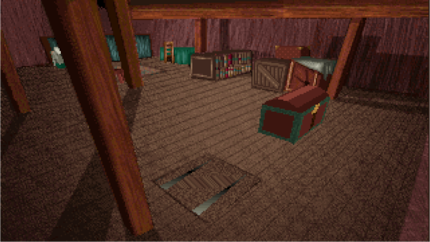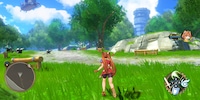
Background information
An epic quest: finding the best «The Lord of the Rings» game
by Rainer Etzweiler

In 1992, "Alone in the Dark" founded a new genre that is still hugely popular today. I'll explain what's left of that time and why the forefather of survival horror has been overtaken by the competition.
Scary monsters, strict resource management and fixed camera angles: this is what characterises the first real survival horror game. We're not talking about "Resident Evil", but "Alone in the Dark". This was released four years before Capcom's zombie classic.
How is it that "Alone in the Dark" founded the genre and has almost been forgotten today?
In the early 90s, 3D gaming was still in its infancy. The first attempts were made in various directions. One example of an early 3D game is the 3D platformer "Alpha Waves", developed by Christophe de Dinechin and published by Infogrames. Infogrames is now part of Atari.
At this time, Frédérick Raynal was also working at the same development company. He is the key figure in the first "Alone in the Dark". Frédérick gained experience in 3D development by porting "Alpha Waves" from the Atari ST to DOS. The then CEO of Infogrames, Bruno Bonnell, then suggested a game in which players had to find their way around a dark environment with the help of a match.
Horror fan Frédérick Raynal took on the project and thought about how he could circumvent the technical limitations of the time. A detailed 3D environment, such as a walk-through house, was unthinkable at the time. This is how the fixed backgrounds and camera angles in which the polygonal figures move are created and which will accompany the genre for quite some time. "Alone in the Dark" thus became a milestone in the history of gaming.

Even though Frédérick Raynal saw many flaws in his game towards the end of development, "Alone in the Dark" was a huge success when it was released. By the end of the millennium, the game had sold over 2.5 million copies. "Alone in the Dark" thrills with its technology, but also with its eerie atmosphere.
You can never feel safe in the game's mansion. Traps and monsters can take you by surprise at any time. You can counteract this by skilfully using objects and solving puzzles. For example, a zombie will appear from a trapdoor early on in the game as soon as you open a certain crate. You can prevent this by pushing the crate onto the trapdoor before opening it. This intuitive puzzle design turns survival in the house into an adventure.

A successful formula is naturally copied. The most prominent example of this is "Resident Evil" from 1996, with which Capcom launched a game series that became a genre leader. Incidentally, the genre name "Survival Horror" has only existed since "Resident Evil". "Alone in the Dark" describes itself as a "virtual adventure game" when it is released.
The similarities between "Alone in the Dark" and "Resident Evil" are unmistakable. In both games, you have to survive in a huge mansion that is overrun by monsters. Weapons and healing items are rare, in stark contrast to the many puzzles you have to solve to progress. Resident Evil" also takes a leaf out of its stylistic book: The fixed camera angles allow for outstanding graphics because less has to be calculated than with a freely swivelling camera. At the same time, the restricted field of vision creates a claustrophobic atmosphere. Less popular elements such as the tank controls also make it into Capcom's game.
"Resident Evil" is more than just a clone of "Alone in the Dark"; otherwise the series would hardly still exist today. Some elements are not only adopted, but improved. One example can be found in an early jump scare from both games. In "Alone in the Dark", a zombie chicken jumps around in front of the attic window. This creates a tense atmosphere. This is taken to extremes as soon as the zombie chicken breaks through the window and attacks. There are no zombie chickens in "Resident Evil", instead there are snarling dogs circling the eerie mansion. In one of the first rooms, one such dog breaks through a window and starts to attack.
Sounds pretty much the same apart from the monster - but it's not. That's because the scene in "Resident Evil" is staged more intensely with camera tricks and provides a greater shock effect. You can't guess the dogs in the windows because, unlike in "Alone in the Dark", you are not made aware of them. That's why, unlike the zombie chicken, the dogs jump into the picture completely unexpectedly. [[video:249322]]
"Resident Evil" successfully continues this formula for the two subsequent games in the series. In part four, the series reinvents itself and sets new foundations for the genre. "Silent Hill" also adopts the formula of "Alone in the Dark", but spins it into a completely different kind of horror that also wins over the hearts of fans.
The influence of "Alone in the Dark" on an entire genre is enormous. Nevertheless, the brand still leads a niche existence today.
The reason lies in the sequels. Despite the success of the first "Alone in the Dark", parts 2 and 3 from 1993 and 1995 no longer captured the magic. One reason for this is the departure of Frédérick Raynal and his development team and the resulting change in strategy.
One of the two protagonists from the first part, Edward Carnby, becomes the mascot of the series. Instead of embodying a defenceless detective, he suddenly shoots down hordes of villains. He becomes an action hero and the eerie atmosphere of the games is lost. It also doesn't help that the technology doesn't make another leap after the first part.
After the trilogy, the series was silent for a few years until "Alone in the Dark: The New Nightmare" was released in 2001. Now it is "Resident Evil" that serves as the template for the reboot. Nevertheless, it is one of the better games in the series. The game is well received and sells almost 1.4 million copies by the end of 2005. After that, things started to go downhill again.
Like other survival horror franchises, "Alone in the Dark" flirted with its own film series. The films were released in 2005 and 2008 under the names "Alone in the Dark" and "Alone in the Dark II" and flopped spectacularly. They are prime examples of bad game film adaptations. Another reboot was also released in 2008, again called "Alone in the Dark". The critics are cautious. The game is ambitious, but the overloaded controls and confusing story are off-putting. You will also look in vain for innovation. The reboot sold less well than its predecessor, but still managed to sell 1.2 million copies worldwide by the end of July 2008.
A full seven years later, the co-op shooter "Alone in the Dark: Illumination" was released. In this game, four characters have to work together to solve a creepy mystery. The soulless "Left 4 Dead 2" clone also copies a bit of "Alan Wake". As in Remedy's creepy game, monsters must first be illuminated with light before you can defeat them. The game was not well received by either the trade press or players.
In 2018, Atari SA, which was called Infogrames until 2009, sold the franchise to the Swedish publisher THQ Nordic.
Despite the downward spiral, it is impressive what a game from 1992 could do for an entire genre. Without "Alone in the Dark", "Resident Evil" might never have existed. Or the games would have developed in a completely different direction.
Drafts of "Resident Evil" show that the game originally focussed on a first-person view. This alone would have resulted in a completely different game.
The latest reboot was recently released, which is once again called "Alone in the Dark". This means that there are now three games with the same name. I tested the game and am impressed. It doesn't reinvent the survival horror genre like the first title. Nevertheless, it is a solid new entry for a game series that hasn't produced a decent game in over 20 years. Let's hope we don't have to wait that long for the next instalment.
I wrote my first text about video games when I was eight years old. I haven't been able to stop since. The rest of my time is spent on my love for 2D husbandos, monsters, my cats and sport.
Interesting facts about products, behind-the-scenes looks at manufacturers and deep-dives on interesting people.
Show all
Background information
by Rainer Etzweiler

Background information
by Philipp Rüegg

Background information
by Rainer Etzweiler